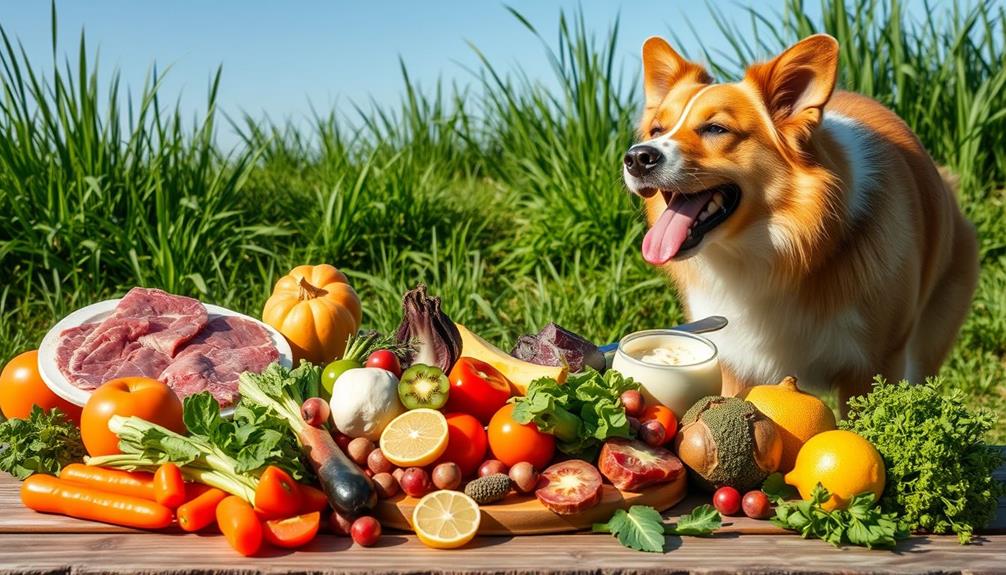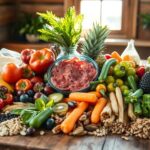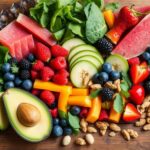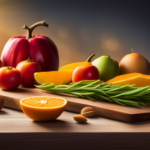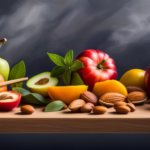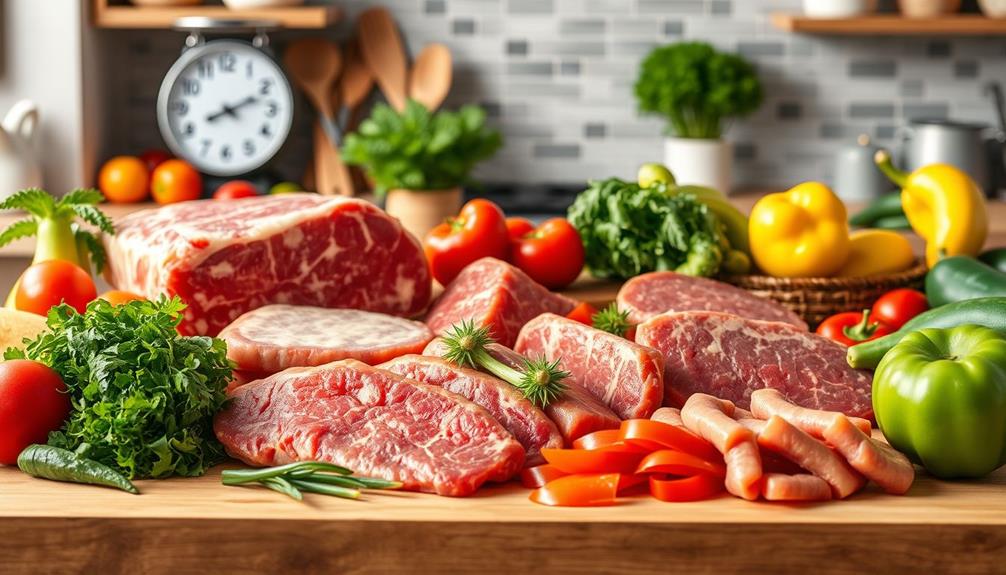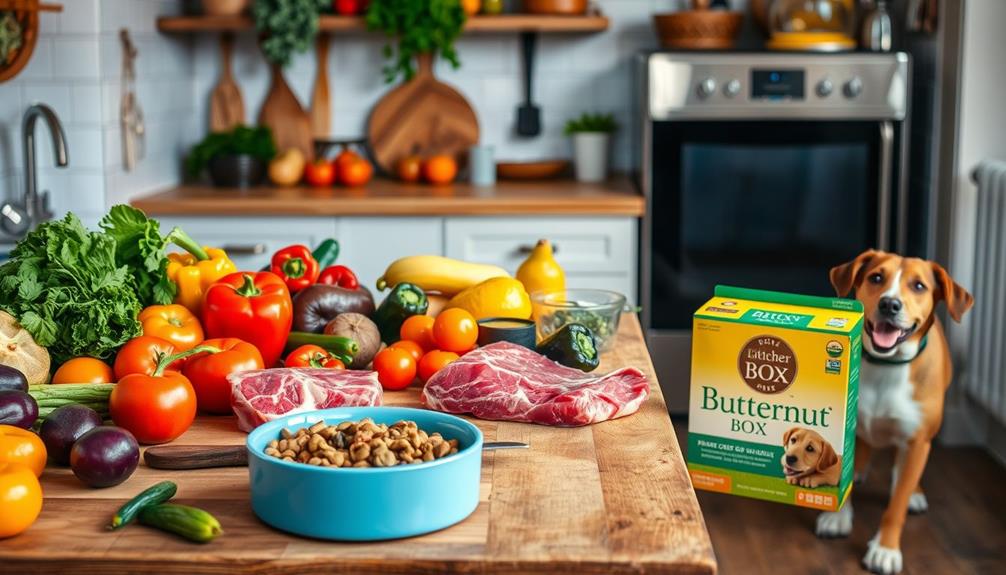The raw food diet revolves around eating uncooked and unprocessed foods, primarily fruits, vegetables, nuts, seeds, and sprouted grains. By keeping cooking temperatures below 104–118°F, you preserve essential nutrients that cooking often destroys. This approach can lead to weight loss and improved heart health while providing high fiber for better digestion. However, you need to be cautious of potential nutritional deficiencies and foodborne illnesses. You'll also want to guarantee proper meal planning to maintain balance. If you're curious about the specific foods to include or tips for meal preparation, there's more to uncover.
Key Takeaways
- The raw food diet emphasizes uncooked, unprocessed foods, focusing on fruits, vegetables, nuts, seeds, and sprouted grains for optimal nutrition.
- Cooking is avoided to preserve nutrients, with food temperatures kept below 104–118°F to maintain their integrity.
- Advocates believe this diet can lead to improved digestion, better heart health, and reduced risk of chronic diseases.
- Careful meal planning is crucial to address potential nutritional deficiencies, particularly in vitamin B12, calcium, and vitamin D.
- Long-term adherence can be challenging due to its restrictive nature, limited dining options, and higher costs of organic ingredients.
Understanding the Raw Food Diet
The raw food diet is all about embracing the natural goodness of uncooked, unprocessed foods. You'll primarily focus on fruits, vegetables, nuts, seeds, and sprouted grains, keeping temperatures below 104–118°F to preserve crucial nutrients and enzymes. Advocates of this diet believe that cooking destroys essential nutrients, which can lead to various health benefits, including improved digestion, increased energy, and a lower risk of chronic diseases.
This approach emphasizes organic ingredients and locally sourced produce to enhance nutritional value and reduce pesticide exposure. Preparation methods like blending, juicing, dehydrating, and soaking allow you to enjoy a variety of textures while keeping meals raw.
One of the appealing aspects of the raw food diet is its potential for weight loss, given its low-calorie density and high fiber content. However, you need to be cautious, as the diet can lead to nutrient deficiencies if not carefully planned.
Critical vitamins and minerals may be lacking, so make sure to incorporate a wide range of uncooked foods to meet your nutritional needs. Balancing your meals is key to reaping the benefits without compromising your health.
Foods to Include and Avoid
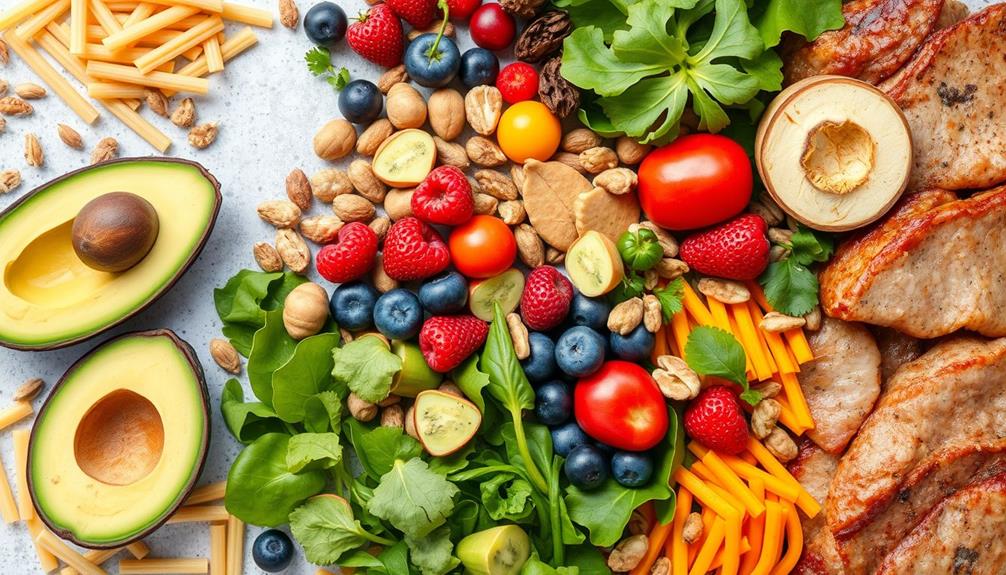
Choosing the right foods is vital to successfully following a raw food diet. Focus on incorporating a variety of raw fruits, vegetables, nuts, and seeds into your meals. These foods should ideally be organic and unprocessed to maintain their nutritional integrity.
Sprouted grains can also be included for additional variety. Including ingredients like significant oils for holistic health can enhance your overall well-being, as some oils like peppermint and eucalyptus may support respiratory health and alleviate discomfort during dietary changes significant oils for respiratory health.
While many followers of the raw food diet avoid animal products, some may choose to consume raw eggs, unpasteurized dairy, and even raw meat or fish. If you decide to go this route, it's important to handle these items properly to minimize health risks associated with foodborne illnesses.
Always verify that raw foods are kept at temperatures below 104–118°F (40–48°C) to preserve valuable nutrients and enzymes.
On the flip side, steer clear of packaged foods, cooked grains, and highly processed products, as these don't align with the raw food philosophy. Additionally, make certain to thoroughly wash and prepare your raw vegetables and fruits, especially leafy greens, to reduce the risk of foodborne illnesses.
Following these guidelines will help you enjoy a safe and nutritious raw food diet.
Health Benefits and Risks
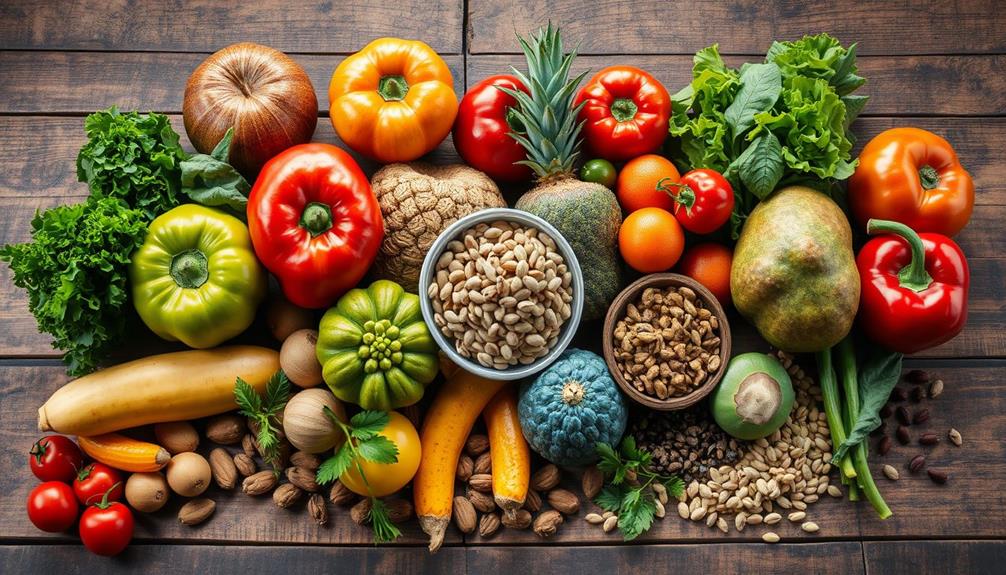
Following a raw food diet can bring a range of health benefits, but it also comes with considerable risks. This diet, rich in nutrient-dense fruits and vegetables, can markedly improve your heart health by lowering blood pressure and cholesterol levels. You might experience effective weight loss, with participants losing an average of 22 to 26 pounds over 3.5 years. High fiber content in raw foods also aids digestion, helping alleviate gastrointestinal disorders.
However, the raw food diet isn't without its dangers. Nutritional deficiencies are a considerable concern, especially regarding vitamin B12, calcium, and vitamin D. These deficiencies can lead to anemia and other serious health issues. Additionally, women may face menstrual irregularities, with 70% experiencing disruptions due to low calorie intake and considerable weight loss.
Here's a quick summary of the benefits and risks:
| Health Benefits | Risks | Key Nutrients |
|---|---|---|
| Improved heart health | Nutritional deficiencies | Vitamin B12 |
| Weight loss | Gastrointestinal disorders | Calcium |
| Enhanced digestion | Menstrual irregularities | Vitamin D |
Meal Preparation and Planning
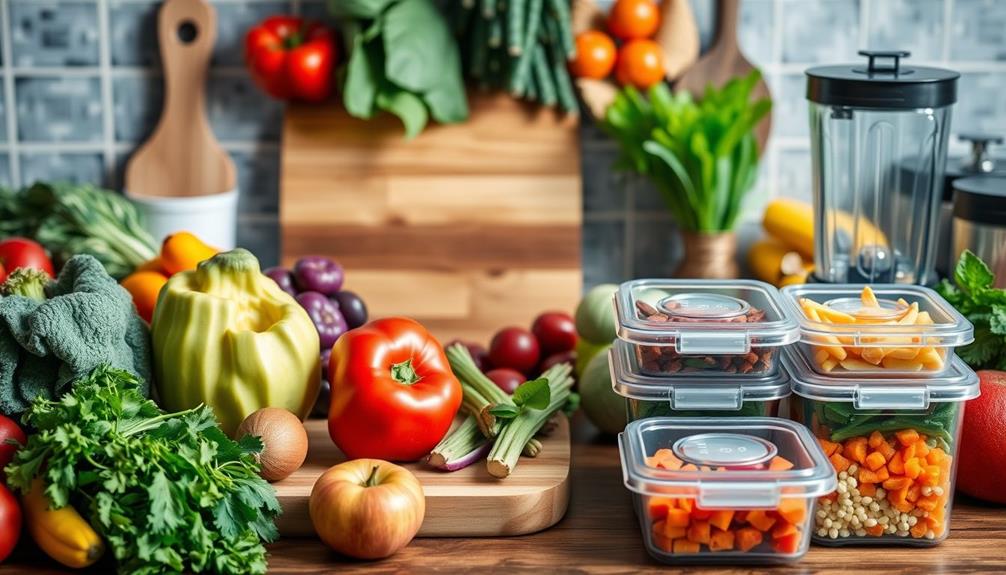
When you're diving into a raw food diet, meal preparation and planning become essential to guarantee you get the most out of your meals. Focus on incorporating at least 75% of your daily intake from raw foods, like fruits, vegetables, nuts, seeds, and sprouted grains, to ensure nutrient diversity.
Additionally, consider including raw juices as they can be rich in antioxidants and offer various health benefits, such as promoting hydration and aiding in digestive health high levels of antioxidants.
Meal preparation often involves soaking and sprouting grains and legumes, which enhances their nutritional value. You'll want to invest in high-quality blenders and dehydrators, as they can help you create a variety of delicious raw dishes while preserving nutrients.
Remember, proper washing and handling of your ingredients are vital to minimize foodborne illness risks, especially with items like unpasteurized dairy or raw meats.
Creating a meal plan can help you stay organized and guarantee balanced nutrition. Consider keeping a food diary to track your intake, manage calorie consumption, and monitor how your body feels with the raw foods diet.
With thoughtful meal preparation, you'll not only enjoy diverse flavors but also embrace a healthier lifestyle that aligns with your raw food journey.
Long-Term Sustainability and Challenges
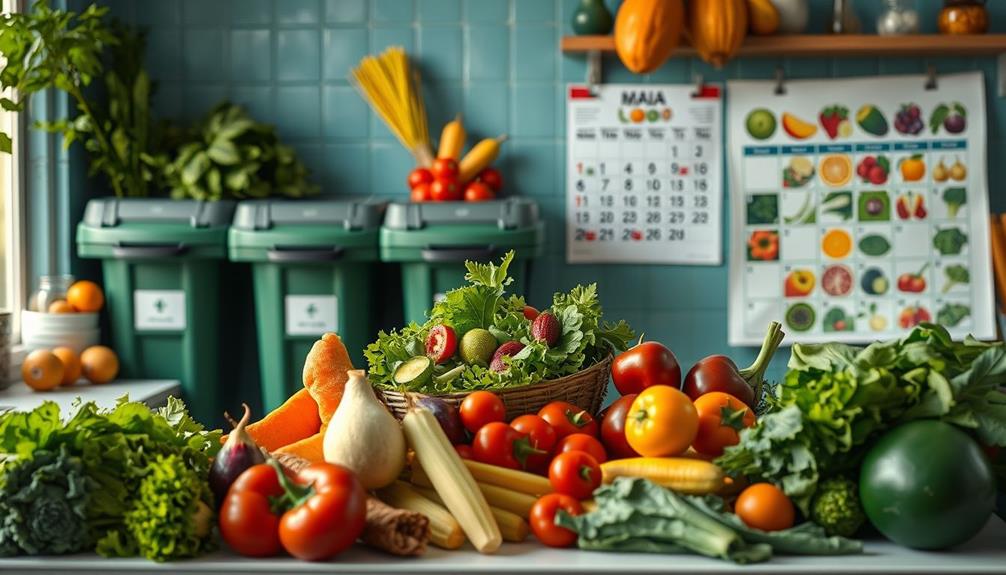
Steering through the long-term sustainability of a raw food diet can present various challenges that you'll need to contemplate. While this diet can lead to weight loss, maintaining those results often proves difficult due to its restrictive nature. You might face nutritional deficiencies in essential areas like vitamin B12, iron, and omega-3 fatty acids if you don't plan your meals carefully.
Moreover, adhering to a raw food diet can complicate social situations. Limited dining options make eating out a challenge, and you may find it hard to enjoy gatherings with friends. The initial costs of organic ingredients and necessary food preparation tools like high-end blenders can also add up quickly.
Here's a quick overview of some challenges:
| Challenge | Description |
|---|---|
| Nutritional Deficiencies | Risk of lacking essential nutrients |
| Social Situations | Limited options can make meals with others tough |
| Cost of Ingredients | Higher expenses for organic foods |
| Food Preparation | Significant time and effort required |
| Varied Diet | Hard to maintain diversity in meals |
Considering these factors is essential for anyone thinking about long-term adherence to the raw food diet.
Frequently Asked Questions
How Does the Raw Food Diet Work?
The raw food diet focuses on consuming uncooked, unprocessed foods to maximize nutrient retention. You enjoy fruits, vegetables, nuts, and seeds, believing that cooking diminishes crucial enzymes and nutrients essential for your health. Raw food diet benefits include improved digestion, increased energy levels, and better overall health. Advocates of this dietary approach also claim that it can help with weight loss and reduce the risk of chronic diseases. Additionally, the high fiber content in raw foods can promote a feeling of fullness and support a healthy digestive system. Is raw food diet healthy? While the raw food diet can offer numerous health benefits, it is important to ensure that you are still receiving all the essential nutrients your body needs. It may require some careful planning to meet all your nutritional needs, especially for certain vitamins and minerals that are more easily absorbed from cooked foods. It is important to consult with a healthcare professional or nutritionist to ensure that you are maintaining a balanced and healthy diet while following a raw food approach.
What Does a Balanced Raw Diet Look Like?
A balanced raw diet includes at least 75% raw foods, like colorful fruits and vegetables, nuts, and sprouted grains. It guarantees you get essential nutrients while enjoying a diverse, flavorful range of meals each day.
What Happens if You Only Eat Raw Food?
If you only eat raw food, you'll likely lose weight and boost your digestion. However, you might face nutrient deficiencies and dental issues, plus there's a risk of foodborne illnesses without proper food handling.
What Can't You Eat on a Raw Food Diet?
On a raw food diet, you can't eat cooked foods, packaged snacks, or processed items. This means no meats, dairy, grains, or legumes unless they're sprouted or soaked. Stick to whole, unprocessed foods instead.
Conclusion
Just like a garden flourishes with sunlight and water, your body thrives on the vibrant energy of raw foods. Embracing the raw food diet can be an invigorating journey, but it's crucial to navigate its twists and turns wisely. By carefully choosing what to plant in your daily meals and nurturing your health, you can cultivate a lifestyle that blooms with vitality. Remember, balance is the key to a fruitful harvest, so enjoy the process and adapt as needed!


